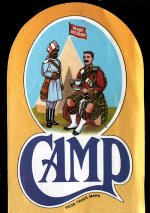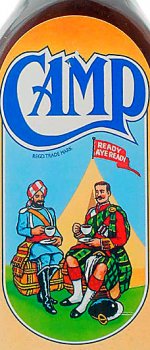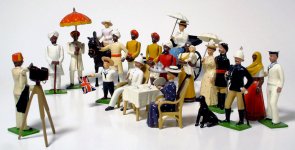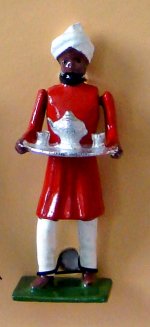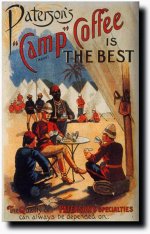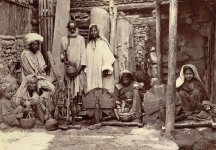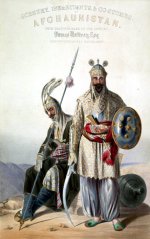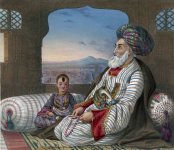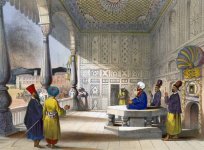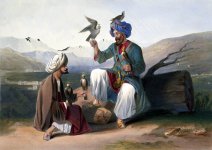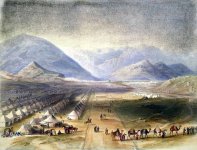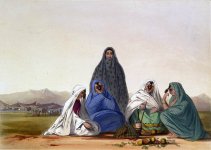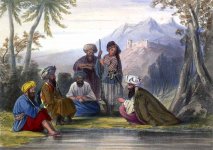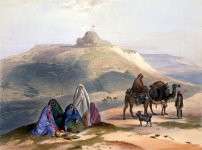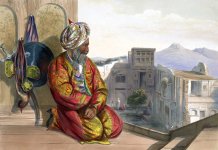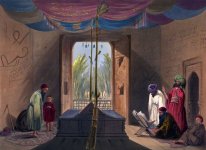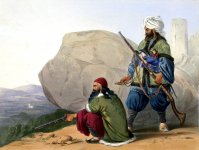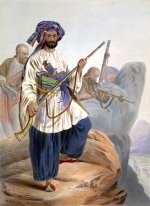You are using an out of date browser. It may not display this or other websites correctly.
You should upgrade or use an alternative browser.
You should upgrade or use an alternative browser.
Colonial India & The North-West Frontier (1 Viewer)
- Thread starter PolarBear
- Start date
PolarBear
Major
- Joined
- Feb 24, 2007
- Messages
- 6,706
The Sikh servant and the military in toy soldiers:
Wm. Hocker Set 118 Our Army At Rest in India
Mr. Hocker's Victorian Army At Ease series provides an excellent view of the social and cultural aspects of life in the Raj.
Wm. Hocker Set 118 Our Army At Rest in India
Mr. Hocker's Victorian Army At Ease series provides an excellent view of the social and cultural aspects of life in the Raj.
Attachments
Louis Badolato
Lieutenant General
- Joined
- Apr 25, 2005
- Messages
- 18,442
I have to say Polarbear, you have a great deal of interesting knowledge about the Raj. I have been really enjoying this thread.

PolarBear
Major
- Joined
- Feb 24, 2007
- Messages
- 6,706
I have to say Polarbear, you have a great deal of interesting knowledge about the Raj. I have been really enjoying this thread.
Thanks Louis
I am learning this along with all of you reading the thread and am enjoying sharing my discoveries.
Randy
PolarBear
Major
- Joined
- Feb 24, 2007
- Messages
- 6,706
James Rattray (1818-1854)
Scenery, Inhabitants, & Costumes, of Afghaunistan*
From Drawings Made on the Spot
* Spelling of Afghanistan in the 1840s.
The First Afghan War was the first conflict of The Great Game, the 19th century struggle between Great Britain and Russia for power and influence in Central Asia.
“In 1839, England sent an army in Afghanistan to
install a former ruler, Shah Shuja, and to depose
the Amir Dost Mohammad Khan. In 1841, the
Afghans rose against the British in Kabul, killing
British agents and surrounding the British
garrison. Mohammad Akbar Khan, the son of Dost
Mohammad Khan, was the leader of the afghan
resistance. The British army was forced to begun
its retreat from Kabul. In January 1842, 16,500
British and Indian soldiers, tried to escape
Afghanistan. The Afghan soldiers intercepted them
and proceeded to massacre them during the next
seven days. This was probably one of the most
important defeats that the British Army suffered in
his history.”
Among the British soldiers participating in the war was Lt. James Rattray who served in the 2nd Grenadiers, Bengal Army. The combined British and Indian force which was under the control of the British East India Company was known as the Army of the Indus. Rattray in addition to being a soldier was a skilled artist who made detailed sketches of people and places during the First Afghan War. These were later converted into lithographic prints which were published in book form between 1847 and 1848 and published in London by Hering & Remington. The book included 30 hand-colored plates. Rattray’s work was meticulous and showed a keen eye for detail providing us with a treasure trove of visual documentation of both geography and history. The book gives us a good sense of the North-West Frontier in the first half of of the 19th Century.
I will gradually post all 30 illustrations with commentary from the British Library which owns a copy of Rattray's book.
Plate 1 Dourraunnee chieftains in full armour
This lithograph was taken from the frontispiece of 'Afghaunistan' by Lieutenant James Rattray. Two Afghan nobles of the Durrani tribe are depicted, fully armed, with their helmets decorated with peacock feathers.
Rattray wrote: "This costume of the Douranee warriors gives a fair idea of the style of armour worn by the Afghaun noblesse, though it was not a common occurrence to meet with them so completely clothed in clinquant mail as they are represented in the frontispiece." Peacock feathers were a symbol of royalty. Egret plumes were specially presented by the Emir as a mark of honour to the chiefs who merited the distinction. Rattray had often been shown the shirts of mail worn by the Afghans under their silk kameezes (shirts) as a protection against assassins' daggers. Sometimes they also wore a "shawl around the steel head-piece, the nose-plate and the plume alone attracting attention to the fact of their being helmeted at all". BL
Scenery, Inhabitants, & Costumes, of Afghaunistan*
From Drawings Made on the Spot
* Spelling of Afghanistan in the 1840s.
The First Afghan War was the first conflict of The Great Game, the 19th century struggle between Great Britain and Russia for power and influence in Central Asia.
“In 1839, England sent an army in Afghanistan to
install a former ruler, Shah Shuja, and to depose
the Amir Dost Mohammad Khan. In 1841, the
Afghans rose against the British in Kabul, killing
British agents and surrounding the British
garrison. Mohammad Akbar Khan, the son of Dost
Mohammad Khan, was the leader of the afghan
resistance. The British army was forced to begun
its retreat from Kabul. In January 1842, 16,500
British and Indian soldiers, tried to escape
Afghanistan. The Afghan soldiers intercepted them
and proceeded to massacre them during the next
seven days. This was probably one of the most
important defeats that the British Army suffered in
his history.”
Among the British soldiers participating in the war was Lt. James Rattray who served in the 2nd Grenadiers, Bengal Army. The combined British and Indian force which was under the control of the British East India Company was known as the Army of the Indus. Rattray in addition to being a soldier was a skilled artist who made detailed sketches of people and places during the First Afghan War. These were later converted into lithographic prints which were published in book form between 1847 and 1848 and published in London by Hering & Remington. The book included 30 hand-colored plates. Rattray’s work was meticulous and showed a keen eye for detail providing us with a treasure trove of visual documentation of both geography and history. The book gives us a good sense of the North-West Frontier in the first half of of the 19th Century.
I will gradually post all 30 illustrations with commentary from the British Library which owns a copy of Rattray's book.
Plate 1 Dourraunnee chieftains in full armour
This lithograph was taken from the frontispiece of 'Afghaunistan' by Lieutenant James Rattray. Two Afghan nobles of the Durrani tribe are depicted, fully armed, with their helmets decorated with peacock feathers.
Rattray wrote: "This costume of the Douranee warriors gives a fair idea of the style of armour worn by the Afghaun noblesse, though it was not a common occurrence to meet with them so completely clothed in clinquant mail as they are represented in the frontispiece." Peacock feathers were a symbol of royalty. Egret plumes were specially presented by the Emir as a mark of honour to the chiefs who merited the distinction. Rattray had often been shown the shirts of mail worn by the Afghans under their silk kameezes (shirts) as a protection against assassins' daggers. Sometimes they also wore a "shawl around the steel head-piece, the nose-plate and the plume alone attracting attention to the fact of their being helmeted at all". BL
Attachments
PolarBear
Major
- Joined
- Feb 24, 2007
- Messages
- 6,706
Rattray Plate 2 Dost Mahommed, King of Caubul, and his youngest son
This is lithograph is taken from plate 2 of 'Afghaunistan' by Lieutenant James Rattray.
Rattray was in the Bengal Army and took part in the first Afghan War, from 1839 to 1842. This conflict saw Dost Mohammed deposed as Emir of Afghanistan. Rattray was granted an audience with the Emir in Peshawar in January 1841. At this time, Dost Mohammed was a prisoner of state and on his way to exile in Calcutta.
Rattray was struck by the Emir's deep voice, open manner and intelligent countenance, and by his followers with their finely chiselled features and tall, handsome figures. The young boy with his head shaven in the manner "peculiar to the rosy-cheeked children of Caubul" was the Emir's son from his youngest wife. Rattray wrote that since Dost Mohammed had been "a ruler just and merciful and attentive to affairs of state ... the population of Peshawur considered him to be most unjustly treated by us." The decorations of this apartment were a facsimile of the Emir's former audience hall in the citadel of Ghazni. BL
This is lithograph is taken from plate 2 of 'Afghaunistan' by Lieutenant James Rattray.
Rattray was in the Bengal Army and took part in the first Afghan War, from 1839 to 1842. This conflict saw Dost Mohammed deposed as Emir of Afghanistan. Rattray was granted an audience with the Emir in Peshawar in January 1841. At this time, Dost Mohammed was a prisoner of state and on his way to exile in Calcutta.
Rattray was struck by the Emir's deep voice, open manner and intelligent countenance, and by his followers with their finely chiselled features and tall, handsome figures. The young boy with his head shaven in the manner "peculiar to the rosy-cheeked children of Caubul" was the Emir's son from his youngest wife. Rattray wrote that since Dost Mohammed had been "a ruler just and merciful and attentive to affairs of state ... the population of Peshawur considered him to be most unjustly treated by us." The decorations of this apartment were a facsimile of the Emir's former audience hall in the citadel of Ghazni. BL
Attachments
PolarBear
Major
- Joined
- Feb 24, 2007
- Messages
- 6,706
Rattray Plate 3 Interior of the palace of Shauh Shujah Ool Moolk, Late King of Cabul
This scene shows Shah Shuja in 1839 after his enthronement as Emir of Afghanistan in the Bala Hissar (fort) of Kabul. Rattray wrote: "The Shah was a man of great personal beauty, and so well got up, that none could have guessed his age." He continued: "the wild grandeur of the whole pageantry baffles description."
The population watched Shuja's grand entry in absolute silence. He was then seated on a white and reputedly ancient marble throne. From here he could be seen by the court in the quadrangle below. The wooden arches and pillars surrounding him were carved and painted and the ceiling richly decorated. A year later the sanctity of the scene was bloodily violated: Shah Shuja was murdered and "the sacred throne, [became] a lounge, a pitch-and-toss table." BL
This scene shows Shah Shuja in 1839 after his enthronement as Emir of Afghanistan in the Bala Hissar (fort) of Kabul. Rattray wrote: "The Shah was a man of great personal beauty, and so well got up, that none could have guessed his age." He continued: "the wild grandeur of the whole pageantry baffles description."
The population watched Shuja's grand entry in absolute silence. He was then seated on a white and reputedly ancient marble throne. From here he could be seen by the court in the quadrangle below. The wooden arches and pillars surrounding him were carved and painted and the ceiling richly decorated. A year later the sanctity of the scene was bloodily violated: Shah Shuja was murdered and "the sacred throne, [became] a lounge, a pitch-and-toss table." BL
Attachments
PolarBear
Major
- Joined
- Feb 24, 2007
- Messages
- 6,706
Rattray Plate 4 Hawkers of Ko-i-staun, with Valley of Caubul and Mountains of Hindoocoosh
In September 1841 Rattray sketched two men from Kohistan, Khudadard and Guldin, who were part of the cavalry escort of his brother, Captain Rattray.
In their capacity as falconers they also accompanied the brothers on sporting rides. Two kinds of birds of prey were used for hunting: the 'chirk' for antelope, bustard and other large game; the 'baz' for smaller quarry like partridge and quail. After the hunting season the birds were released. If recaptured, they were sternly schooled to accept their masters, kept in a darkened room, starved and then fed. Six weeks was the usual period taken to 'form' a bird. Rattray wrote: "That an old hawk should be rendered so docile and clever is wonderful, much more so when the same bird has been captured by the same fowler for several successive years."
Rattray's brother was killed in this beautiful valley only a month later. BL
In September 1841 Rattray sketched two men from Kohistan, Khudadard and Guldin, who were part of the cavalry escort of his brother, Captain Rattray.
In their capacity as falconers they also accompanied the brothers on sporting rides. Two kinds of birds of prey were used for hunting: the 'chirk' for antelope, bustard and other large game; the 'baz' for smaller quarry like partridge and quail. After the hunting season the birds were released. If recaptured, they were sternly schooled to accept their masters, kept in a darkened room, starved and then fed. Six weeks was the usual period taken to 'form' a bird. Rattray wrote: "That an old hawk should be rendered so docile and clever is wonderful, much more so when the same bird has been captured by the same fowler for several successive years."
Rattray's brother was killed in this beautiful valley only a month later. BL
Attachments
PolarBear
Major
- Joined
- Feb 24, 2007
- Messages
- 6,706
Rattray Plate 5 Encampment of the Kandahar Army, under General Nott
Lieutenant Rattray wrote of this scene: "After a march of 210 miles through the most desolate and terrific mountain passes in the world, the view ... bursts suddenly on the delighted eyes of the fastness-wearied soldier."
The encampment of the troops led by General Sir William Nott lay on the vast plain of Chaman-e-Shah. Kabul is pictured in the distance. Towering above all are the heights of Paghman. Rattray wrote that if this commanding and secure site had been taken earlier during the Afghan campaign, it "in all probability could have prevented that long series of unparalleled disasters, reverses, crimes and errors, which ended in our total annihilation." A mark in the high road, running through the centre of the sketch, indicates the spot where Shah Shuja was murdered. BL
Lieutenant Rattray wrote of this scene: "After a march of 210 miles through the most desolate and terrific mountain passes in the world, the view ... bursts suddenly on the delighted eyes of the fastness-wearied soldier."
The encampment of the troops led by General Sir William Nott lay on the vast plain of Chaman-e-Shah. Kabul is pictured in the distance. Towering above all are the heights of Paghman. Rattray wrote that if this commanding and secure site had been taken earlier during the Afghan campaign, it "in all probability could have prevented that long series of unparalleled disasters, reverses, crimes and errors, which ended in our total annihilation." A mark in the high road, running through the centre of the sketch, indicates the spot where Shah Shuja was murdered. BL
Attachments
PolarBear
Major
- Joined
- Feb 24, 2007
- Messages
- 6,706
Rattray Plate 6 Ghiljie women in the lower orders
This sketch was made on one of Rattray's journeys from Kabul to Kandahar with an Afghan escort. Rattray was uncomfortably aware that his companions could easily and quietly dispose of him, given the length of the journey and the remoteness of some of the places they passed through.
Rattray's group often came across roving bands of western Ghilzais, who lived a nomadic life from season to season, searching for pasture for their flocks. Their black felt tents stretched over twigs resembled a "flock of enormous bats skimming over the flat surface of the plain". Their women drove their camels, bullocks and donkeys, "laden sky-high with the most singular mix of goods and chattels". The unmarried Ghilzai women bore a peculiar badge of virginity on their foreheads: "[bringing] the whole of their hair to the front of their face, and kneading it into a compact cake with an admixture of dung and mud, ornament it with beads, bits of metal and coloured glass." Some of them were very pretty, Rattray observed, but others were squint-eyed from peering around the sides of their "odious distinction". BL
This sketch was made on one of Rattray's journeys from Kabul to Kandahar with an Afghan escort. Rattray was uncomfortably aware that his companions could easily and quietly dispose of him, given the length of the journey and the remoteness of some of the places they passed through.
Rattray's group often came across roving bands of western Ghilzais, who lived a nomadic life from season to season, searching for pasture for their flocks. Their black felt tents stretched over twigs resembled a "flock of enormous bats skimming over the flat surface of the plain". Their women drove their camels, bullocks and donkeys, "laden sky-high with the most singular mix of goods and chattels". The unmarried Ghilzai women bore a peculiar badge of virginity on their foreheads: "[bringing] the whole of their hair to the front of their face, and kneading it into a compact cake with an admixture of dung and mud, ornament it with beads, bits of metal and coloured glass." Some of them were very pretty, Rattray observed, but others were squint-eyed from peering around the sides of their "odious distinction". BL
Attachments
PolarBear
Major
- Joined
- Feb 24, 2007
- Messages
- 6,706
Rattray Plate 7 Khoja Padshauh, a Ko-i-staun chief, with his armed retainers
Together with his brother's regiment, Rattray went on a reconnoitering tour of the valleys of Afghanistan. The group in this picture, he wrote, "formed one of the numerous escorts which, in our rides from fort to fort through the valley, poured out, headed by their respective Khauns to do honour to and swell the train of the big-wigs". Khoja Padshah, the principal figure here, was allowed by the British to escape from the storming of Julga Fort in 1840.
While on this tour, the reconnaisance force happened upon the ancient ruins of what Rattray refers to as the Caucasian Alexandria, overlooking the plains of Begram. They were able to inspect the famous tomb of Alexander's steed Bucephalus at the site. Coins, rings and other antiques were dug up by the villagers and proffered to the British. BL
Together with his brother's regiment, Rattray went on a reconnoitering tour of the valleys of Afghanistan. The group in this picture, he wrote, "formed one of the numerous escorts which, in our rides from fort to fort through the valley, poured out, headed by their respective Khauns to do honour to and swell the train of the big-wigs". Khoja Padshah, the principal figure here, was allowed by the British to escape from the storming of Julga Fort in 1840.
While on this tour, the reconnaisance force happened upon the ancient ruins of what Rattray refers to as the Caucasian Alexandria, overlooking the plains of Begram. They were able to inspect the famous tomb of Alexander's steed Bucephalus at the site. Coins, rings and other antiques were dug up by the villagers and proffered to the British. BL
Attachments
PolarBear
Major
- Joined
- Feb 24, 2007
- Messages
- 6,706
Rattray Plate 8 Kelaut-I-Ghiljie
The fortress of Kalat-i-Ghilzai stood 81 miles from the Kandahar on the high road to Kabul. It held a British garrison under Captain Craigie of the 43rd Bengal Light Infantry, which was put under siege by the Ghilzais and cut off for six months from all other garrisons. Success in Kabul had given the Ghilzais so much confidence that their women waited in the ravines close by to share in the plunder. The garrison was finally relieved by a brigade from Kandahar in May 1842. Rattray was among the relieving troops, and wrote: "Far distant from any other station, exposed to sharp and piercing winds and visited by terrible sandstorms, surrounded as far as the eye could reach by bare precipices, tremendous defiles and ravines, heaped together in the most chaotic confusion, like the great breakers of a winter ocean suddenly frozen in belts of mountains, all smitten with the curse of barrenness." BL
The fortress of Kalat-i-Ghilzai stood 81 miles from the Kandahar on the high road to Kabul. It held a British garrison under Captain Craigie of the 43rd Bengal Light Infantry, which was put under siege by the Ghilzais and cut off for six months from all other garrisons. Success in Kabul had given the Ghilzais so much confidence that their women waited in the ravines close by to share in the plunder. The garrison was finally relieved by a brigade from Kandahar in May 1842. Rattray was among the relieving troops, and wrote: "Far distant from any other station, exposed to sharp and piercing winds and visited by terrible sandstorms, surrounded as far as the eye could reach by bare precipices, tremendous defiles and ravines, heaped together in the most chaotic confusion, like the great breakers of a winter ocean suddenly frozen in belts of mountains, all smitten with the curse of barrenness." BL
Attachments
PolarBear
Major
- Joined
- Feb 24, 2007
- Messages
- 6,706
Rattray Plate 9 'Atmaran', Hindoo of Peshawar
In September 1841, Rattray received a note from the British Political Agent in Kabul, Alexander Burnes, asking him to prepare for the visit of Atmaram, the prime minister of Mir Murad Beg and ruler of Kunduz. Originally from Peshawar, Atmaram was a Hindu of humble origins who had risen to Dewan Beg of Kunduz by talent and skill. Also in his favour was his ability to read and write, in an age when most Uzbegs were illiterate. Splendidly attired in Uzbeg style (he was the first Hindu permitted to sport turban and cummerbund), he retained his red Hindu caste mark on his forehead. He had on many occasions used his influence with Murad Beg to save Burnes and other British officials from death or imprisonment on their travels. Rattray wrote of Atmaram as "a sly-looking old fellow, countenance beaming with cunning and intellectual fire", and noted that he had "never betrayed his master's trust". BL
In September 1841, Rattray received a note from the British Political Agent in Kabul, Alexander Burnes, asking him to prepare for the visit of Atmaram, the prime minister of Mir Murad Beg and ruler of Kunduz. Originally from Peshawar, Atmaram was a Hindu of humble origins who had risen to Dewan Beg of Kunduz by talent and skill. Also in his favour was his ability to read and write, in an age when most Uzbegs were illiterate. Splendidly attired in Uzbeg style (he was the first Hindu permitted to sport turban and cummerbund), he retained his red Hindu caste mark on his forehead. He had on many occasions used his influence with Murad Beg to save Burnes and other British officials from death or imprisonment on their travels. Rattray wrote of Atmaram as "a sly-looking old fellow, countenance beaming with cunning and intellectual fire", and noted that he had "never betrayed his master's trust". BL
Attachments
PolarBear
Major
- Joined
- Feb 24, 2007
- Messages
- 6,706
Rattray Plate 10 Mosque and Tomb of the Emperor Soolta Mahmood of Ghuznee
The area around the tomb of Mahmud of Ghazni (998-1030) Rattray thought to be one of the most pleasing spots in Afghanistan.
The tomb was entered via a spacious courtyard, watered by a clear stream. Visitors would pass through covered passages to a garden framed by mulberry, plum, pear, peach, apricot, cherry and rose trees. Their blossoms hung over exquisitely carved marble tombs, including Mahmud's. This was a place of pilgrimage, decorated with flowers and peacock feathers: Afghan symbols of royalty.
The folding doors shown were reputed to be the famous Sandalwood Doors, carried off in 1026 by Mahmud after his destruction of the Somnath Temple in Gujarat, during the last of his devastatingly successful forays in India. The British removed them from the tomb in 1842, laboriously transporting them to Agra Fort, where they were found to be replicas of the original. BL
The area around the tomb of Mahmud of Ghazni (998-1030) Rattray thought to be one of the most pleasing spots in Afghanistan.
The tomb was entered via a spacious courtyard, watered by a clear stream. Visitors would pass through covered passages to a garden framed by mulberry, plum, pear, peach, apricot, cherry and rose trees. Their blossoms hung over exquisitely carved marble tombs, including Mahmud's. This was a place of pilgrimage, decorated with flowers and peacock feathers: Afghan symbols of royalty.
The folding doors shown were reputed to be the famous Sandalwood Doors, carried off in 1026 by Mahmud after his destruction of the Somnath Temple in Gujarat, during the last of his devastatingly successful forays in India. The British removed them from the tomb in 1842, laboriously transporting them to Agra Fort, where they were found to be replicas of the original. BL
Attachments
PolarBear
Major
- Joined
- Feb 24, 2007
- Messages
- 6,706
Rattray Plate 11 Afghaun foot soldiers in their winter dress, with entrance to the Valley of Urgundeh
During the severe winters, Afghanis wore a shirt (kameez)under a leathern spencer or half-jacket, which was embroidered in silk and had a wool lining. Thick black cloth trousers, fastened by a rope around the waist and bound with the same material from ankle to knee, were also worn. Amulets, relics and little bags full of texts and prayers were tacked about their clothes.
This Burj (watch-tower) was one of many between the Maidan and Arghani valleys. The British met with considerable resistance at such points on their advance from Kandahar to Kabul. The resisting Afghans were spread along mountain posts and were commanded by two nephews of Dost Mohammed.
The men depicted here belonged to a British regiment called the Rangers, which was raised in Kohistan under the command of Lieutenant Maule of the Artillery, who said that he had his hands full trying to impose discipline among these "wild, unruly, merry fellows". Rattray himself left Kohistan in September 1841, but Maule, his subaltern and European sergeants were murdered by their troops only two months later. BL
During the severe winters, Afghanis wore a shirt (kameez)under a leathern spencer or half-jacket, which was embroidered in silk and had a wool lining. Thick black cloth trousers, fastened by a rope around the waist and bound with the same material from ankle to knee, were also worn. Amulets, relics and little bags full of texts and prayers were tacked about their clothes.
This Burj (watch-tower) was one of many between the Maidan and Arghani valleys. The British met with considerable resistance at such points on their advance from Kandahar to Kabul. The resisting Afghans were spread along mountain posts and were commanded by two nephews of Dost Mohammed.
The men depicted here belonged to a British regiment called the Rangers, which was raised in Kohistan under the command of Lieutenant Maule of the Artillery, who said that he had his hands full trying to impose discipline among these "wild, unruly, merry fellows". Rattray himself left Kohistan in September 1841, but Maule, his subaltern and European sergeants were murdered by their troops only two months later. BL
Attachments
PolarBear
Major
- Joined
- Feb 24, 2007
- Messages
- 6,706
Rattray Plate 12 Ko-i-staun foot soldiery in summer costume
This Kohistani is Mir Alam, formerly one of a band of noted robbers on the road to Turkestan, north-west of Begram. Rattray wrote: "Coistaun has always been remarkable for the war-like character of its inhabitants, who average some forty thousand families famous for the efficiency and excellence of their Pyadas (foot-soldiery). As light infantry they are unrivalled, and from their numbers and determined courage, are of considerable importance in the event of any revolution in which they may take part."
The robber chief Hassan secretly and daringly accosted the British envoy William McNaghten and offered to bring him Dost Mohammmed's head in return for a large amount of money. Although this offer was hastily turned down, Hassan and his men were later enrolled among the infantry escort of Rattray's brother. Giving up their precarious livelihood, they became most efficient soldiers. BL
This Kohistani is Mir Alam, formerly one of a band of noted robbers on the road to Turkestan, north-west of Begram. Rattray wrote: "Coistaun has always been remarkable for the war-like character of its inhabitants, who average some forty thousand families famous for the efficiency and excellence of their Pyadas (foot-soldiery). As light infantry they are unrivalled, and from their numbers and determined courage, are of considerable importance in the event of any revolution in which they may take part."
The robber chief Hassan secretly and daringly accosted the British envoy William McNaghten and offered to bring him Dost Mohammmed's head in return for a large amount of money. Although this offer was hastily turned down, Hassan and his men were later enrolled among the infantry escort of Rattray's brother. Giving up their precarious livelihood, they became most efficient soldiers. BL
Attachments
beating retreat
Corporal
- Joined
- Aug 12, 2008
- Messages
- 552
Hi folks Love this new thread, brilliant idea of yours Randy. Saw the item on tent pegging thought you may like to see this figure, painted from a BMSS casting, Officer 30th Bengal lancers

Regards John

Regards John
Users who are viewing this thread
Total: 2 (members: 0, guests: 2)


